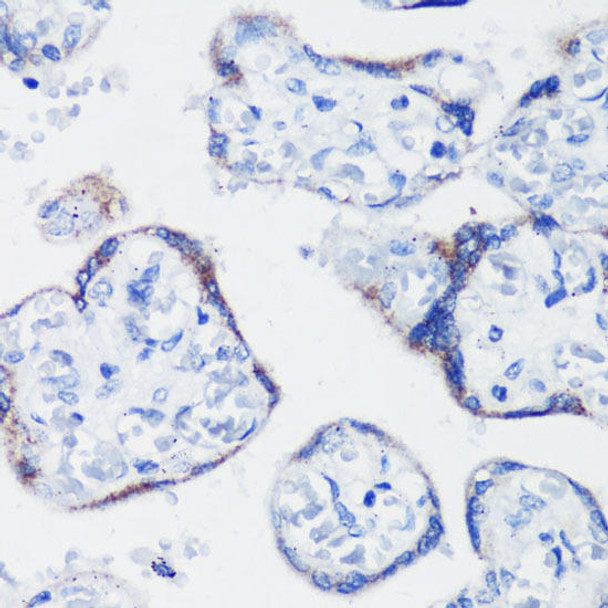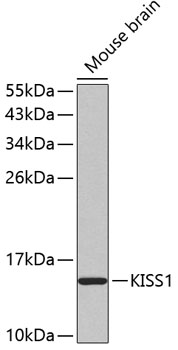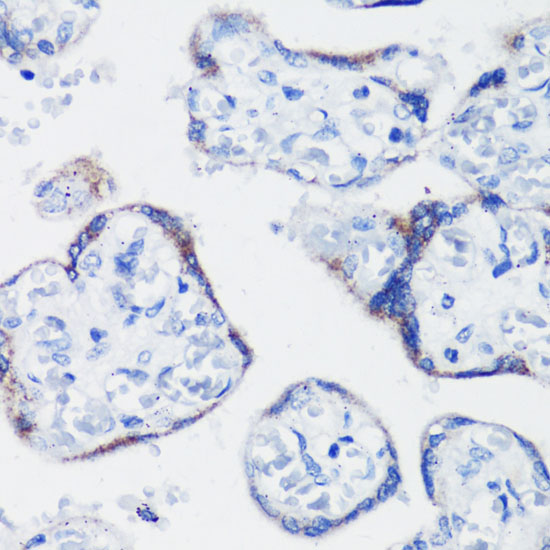Anti-KISS1 Antibody (CAB2987)
- SKU:
- CAB2987
- Product type:
- Antibody
- Reactivity:
- Human
- Mouse
- Host Species:
- Rabbit
- Isotype:
- IgG
- Research Area:
- Cell Biology
Frequently bought together:
Description
| Antibody Name: | Anti-KISS1 Antibody |
| Antibody SKU: | CAB2987 |
| Antibody Size: | 20uL, 50uL, 100uL |
| Application: | WB IHC |
| Reactivity: | Human, Mouse |
| Host Species: | Rabbit |
| Immunogen: | A synthetic peptide of human KISS1 |
| Application: | WB IHC |
| Recommended Dilution: | WB 1:500 - 1:2000 IHC 1:50 - 1:200 |
| Reactivity: | Human, Mouse |
| Positive Samples: | Mouse brain |
| Immunogen: | A synthetic peptide of human KISS1 |
| Purification Method: | Affinity purification |
| Storage Buffer: | Store at -20°C. Avoid freeze / thaw cycles. Buffer: PBS with 0.02% sodium azide, 50% glycerol, pH7.3. |
| Isotype: | IgG |
| Sequence: | Email for sequence |
| Gene ID: | 3814 |
| Uniprot: | Q15726 |
| Cellular Location: | Secreted |
| Calculated MW: | 14kDa |
| Observed MW: | 15kDa |
| Synonyms: | KISS1, HH13, KiSS-1 |
| Background: | This gene is a metastasis suppressor gene that suppresses metastases of melanomas and breast carcinomas without affecting tumorigenicity. The encoded protein may inhibit chemotaxis and invasion and thereby attenuate metastasis in malignant melanomas. Studies suggest a putative role in the regulation of events downstream of cell-matrix adhesion, perhaps involving cytoskeletal reorganization. A protein product of this gene, kisspeptin, stimulates gonadotropin-releasing hormone (GnRH)-induced gonadotropin secretion and regulates the pubertal activation of GnRH nuerons. A polymorphism in the terminal exon of this mRNA results in two protein isoforms. An adenosine present at the polymorphic site represents the third position in a stop codon. When the adenosine is absent, a downstream stop codon is utilized and the encoded protein extends for an additional seven amino acid residues. |
| UniProt Protein Function: | KiSS-1: Metastasis suppressor protein in malignant melanomas and in some breast cancers. May regulate events downstream of cell- matrix adhesion, perhaps involving cytoskeletal reorganization. Generates a C-terminally amidated peptide, metastin which functions as the endogenous ligand of the G-protein coupled receptor GPR54. Activation of the receptor inhibits cell proliferation and cell migration, key characteristics of tumor metastasis. Kp-10 is a decapeptide derived from the primary translation product, isolated in conditioned medium of first trimester trophoblast. Kp-10, but not other kisspeptins, increased intracellular Ca(2+) levels in isolated first trimester trophoblasts. Kp-10 is a paracrine/endocrine regulator in fine- tuning trophoblast invasion generated by the trophoblast itself. The receptor is also essential for normal gonadotropin-released hormone physiology and for puberty. The hypothalamic KiSS1/GPR54 system is a pivotal factor in central regulation of the gonadotropic axis at puberty and in adulthood. Belongs to the KISS1 family. |
| UniProt Protein Details: | Protein type:Secreted; Cell adhesion; Secreted, signal peptide Chromosomal Location of Human Ortholog: 1q32 Cellular Component: extracellular region Molecular Function:protein binding Biological Process: cytoskeleton organization and biogenesis Disease: Hypogonadotropic Hypogonadism 13 With Or Without Anosmia |
| NCBI Summary: | This gene is a metastasis suppressor gene that suppresses metastases of melanomas and breast carcinomas without affecting tumorigenicity. The encoded protein may inhibit chemotaxis and invasion and thereby attenuate metastasis in malignant melanomas. Studies suggest a putative role in the regulation of events downstream of cell-matrix adhesion, perhaps involving cytoskeletal reorganization. A protein product of this gene, kisspeptin, stimulates gonadotropin-releasing hormone (GnRH)-induced gonadotropin secretion and regulates the pubertal activation of GnRH nuerons. A polymorphism in the terminal exon of this mRNA results in two protein isoforms. An adenosine present at the polymorphic site represents the third position in a stop codon. When the adenosine is absent, a downstream stop codon is utilized and the encoded protein extends for an additional seven amino acid residues. [provided by RefSeq, Mar 2012] |
| UniProt Code: | Q15726 |
| NCBI GenInfo Identifier: | 292495092 |
| NCBI Gene ID: | 3814 |
| NCBI Accession: | Q15726.4 |
| UniProt Related Accession: | Q15726 |
| Molecular Weight: | |
| NCBI Full Name: | Metastasis-suppressor KiSS-1 |
| NCBI Synonym Full Names: | KiSS-1 metastasis suppressor |
| NCBI Official Symbol: | KISS1 |
| NCBI Official Synonym Symbols: | HH13; KiSS-1 |
| NCBI Protein Information: | metastasis-suppressor KiSS-1 |
| UniProt Protein Name: | Metastasis-suppressor KiSS-1 |
| UniProt Synonym Protein Names: | Kisspeptin-1Cleaved into the following 4 chains:MetastinAlternative name(s):Kisspeptin-54 |
| Protein Family: | Metastasis-suppressor |
| UniProt Gene Name: | KISS1 |
| UniProt Entry Name: | KISS1_HUMAN |




